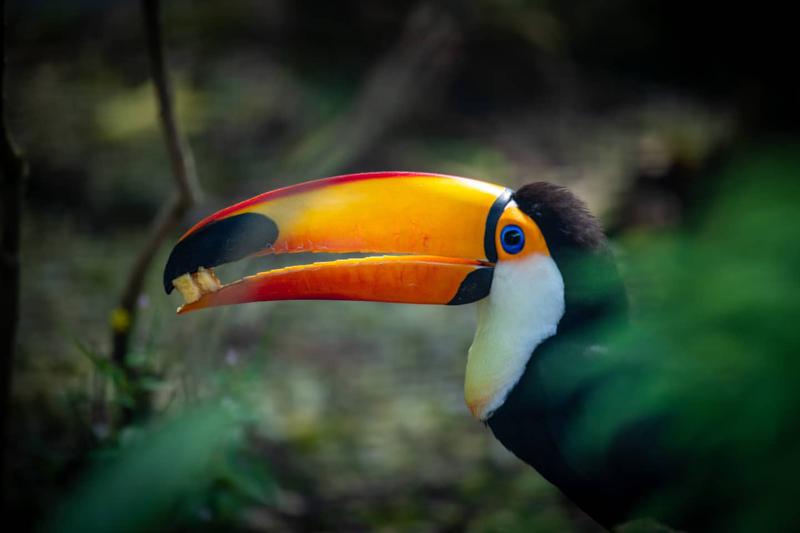Who doesn’t adore our avian companions? You’re not alone if you’ve ever wondered how to get closer to the lovely birds in your area. It takes time and care to establish a trusting relationship with a wild bird, but the benefits are well worth the effort.
For those with limited time, the following is a brief response to your inquiry: To win the confidence of birds, provide them with food and water, wait for them to become used to your presence, and always behave quietly, calmly, and consistently while interacting with them.
We’ll go over tried-and-true methods for politely and securely becoming friends with local wildlife in this extensive tutorial. You’ll discover all there is to know about creating an inviting setting, comprehending bird behavior, and establishing trust via routines.
You’ll soon have lovely avian pals who cheerfully welcome you every day!
Beginning the Process of Feeding Birds
Bird feeding is an excellent method to make friends with birds and draw them to your outside area. You may make your place seem friendly and entice them to come back by giving them a consistent supply of food.
Here are some pointers to get you started feeding birds.
Selecting Appropriate Foods and Feeders
Variety is essential when choosing bird food. Offering a variety of seeds, nuts, fruits, and suet helps draw in a greater variety of birds, since various species have varying nutritional needs. Finding out what kinds of birds are frequent in your region and what they like to eat is a smart idea.
Selecting the appropriate feeds is also crucial. There are several varieties of feeders on the market, such as hopper feeders, platform feeders, and tube feeders. Each variety serves a variety of bird species and eating preferences.
Make sure the feeder openings are appropriate for the birds you want to attract by taking into account their size and shape.
Pro Tip: You might think about hanging a nectar feeder if you want to attract hummingbirds in particular. Hummingbirds will often visit your yard because they are drawn to the delicious nectar.
Perfect Positioning Advice
The efficacy of your bird feeders may be significantly impacted by where you put them. Selecting a spot that gives birds a feeling of security and is readily visible to them is crucial. When feeders are positioned close to trees or bushes, birds have a place to perch and survey their environment before coming near the feeder.
Furthermore, think about putting feeders in locations with natural cover, such next to shrubs or a garden. Birds will feel more secure as a result, increasing the likelihood that they will frequent your feeders.
Pro Tip: Keep feeders away from windows and other reflecting surfaces where birds might confuse them for open areas and fly into the glass. Place feeders at least three feet away from windows or use window decals if you’re worried about windows colliding.
Keeping the Environment Safe and Clean
Maintaining your bird feeders on a regular basis will help to keep the birds’ surroundings tidy and secure. Food that is moist or moldy should be avoided since it may be toxic to birds. At the very least once a month, give your feeders a thorough cleaning with warm, soapy water to get rid of any residue.
Maintaining cleanliness in the vicinity of the feeders is also crucial. To stop the spread of illness, remove any collected bird droppings or spilled food. Check the feeders often for any indications of deterioration, and replace or repair them as necessary.
Pro Tip: Think about placing a small dish or bird bath next to your feeders so they always have access to water. Water is necessary for birds to drink and bathe, so having a water supply close by will draw birds to your yard even more.
Recall that it requires patience and time to draw in and become friends with birds. You may make your backyard a welcome place that will attract a variety of bird species to visit and become residents by using these techniques and routinely refilling the feeders.
Allowing Birds to Get Used to Your Being There
Allowing birds to become used to your presence is one of the most crucial aspects in developing a friendship with them. Due to their innate caution, birds need some time to become used to being near people. The following advice can help you get birds used to human presence:
Going Gently and Silently
Moving slowly and silently is one of the most effective techniques to put birds at peace. Because they are easily startled and startled by loud sounds, birds should always be approached carefully. You may reduce possible distractions and make the birds feel more secure in your presence by moving gently and softly.
Recall that developing trust with our feathery buddies requires time!
Observing Patiently Close by
Another good tactic is to calmly wait close to the birds. Choose a position that is comfortable for you so that you can watch them from a distance without disturbing them. You may help the birds become used to your presence without scaring them by just sitting and watching.
They could even begin to approach you out of curiosity over time. Just be sure you keep a safe distance to prevent upsetting anybody.
Steer clear of abrupt movements
It’s essential to keep your movements slow while around birds. Any jerky or abrupt movements might frighten them and make them uncomfortable being around you. Rather, make an effort to move softly and slowly so that the birds may become used to you without feeling threatened.
By doing this, you show them that you are not harmful and make it more likely that they will see you as a kind person.
Recall that establishing a connection with birds requires patience and time. You’ll be well on your way to creating a relationship with these amazing animals if you heed these suggestions and give the birds time to become used to your presence.
You may visit websites like Audubon.org or BirdWatchersDigest.com to learn more about bird behavior and how to become friends with them.
Acquiring the Trust of a Bird Gradually
Gaining a bird’s trust may be a satisfying and gratifying experience. A lifetime connection may result from forging a close bond with a feathered companion, even if it could take some time and patience. The following actions are crucial to gradually earning a bird’s trust:
Creating a Schedule
Just like us, birds love routine. Establishing a consistent daily routine helps foster trust and provide your feathery companion a sense of security and safety. Make an effort to feed your bird at the same time every day and make sure it has lots of opportunity to socialize outside of its cage.
Building consistency is essential for building trust.
Observing Personal Space
Like people, birds are private property owners. Be aware of your feathery friend’s limits and body language while engaging with them. Steer clear of abrupt movements or loud sounds that might frighten or frighten them.
As they gain confidence, give them the space they need to feel at ease and progressively go toward more physical contact.
Encouraging Positive Interactions on a Regular Basis
Birds are very gregarious animals that like good company. Talk to your bird, give them goodies, and spend time doing things they like to do. Find out what activities or toys kids like playing, then include them in your regular conversations.
When it comes to fostering trust and strengthening your relationship with a bird, positive reinforcement is an invaluable tool.
Recall that establishing trust with birds requires patience and time. Since every bird is distinct, several methods can be needed. Be persistent in your attempts and show them that you value their uniqueness. You may build a solid and trustworthy friendship with your feathery companion with patience and commitment.
Recognizing the Behavior and Communication of Birds
Birds express and communicate in ways that are exclusively their own. It’s essential that you comprehend their communication styles and conduct if you want to become friends. You may get a better knowledge of our feathery companions by being adept at reading their body language, deciphering their vocalizations, and reacting correctly.
Identifying Body Language Cues
Birds communicate a broad variety of feelings and intentions via their body language. You may learn a lot about someone’s present condition by paying attention to their posture and motions. When a bird displays aggressive or territorial behavior, it might be showing indicators of hostility, such as ruffled feathers and an open mouth.
A bird that has relaxed feathers and a serene expression, on the other hand, probably feels comfortable and at rest.
It’s also critical to observe how they move their heads and eyes. If a bird is staring right at you, it might be displaying interest or claiming dominance. A bird that looks away or keeps its head down, on the other hand, can be feeling intimidated or subservient.
You may learn more about the intents and feelings of the birds you see by becoming acquainted with their body language cues.
Analyzing Voices
Birds are recognized for their beautiful melodies and unique sounds. Understanding how to decipher a species’ distinctive vocalizations might help you better understand how they behave and communicate.
For instance, a male songbird attempting to attract a mate is typically indicated by the melodic trill of a bird such as the nightingale. Conversely, many birds’ high-pitched warning cries signal possible danger or the presence of a predator nearby.
It’s also important to remember that birds use various vocalizations for various objectives. While certain vocalizations are used for courting or flock communication, others are utilized for territorial defense.
You may learn more about the birds’ communication attempts by becoming acquainted with their vocalizations.
Taking Appropriate Action
It’s crucial to react correctly after you’ve mastered the art of interpreting bird vocalizations and body language. This entails staying out of their way and honoring their limits.
Give the bird room and refrain from making abrupt moves if it shows symptoms of aggressiveness or discomfort. However, you might attempt engaging with a bird in a kind and non-threatening way if it seems peaceful and inquisitive.
Recall that birds are wild animals, therefore you should always approach them with care and respect. You may establish a deep bond with these incredible animals by learning about their communication styles and behavior.
Improved Methods for Direct Communication
You could be prepared to advance your bird-befriending abilities after you have built up a foundation of trust with the local species. You may develop a closer relationship with these intriguing animals by using advanced tactics for close contact. Here are some methods to think about:
Manual Feeding
Hand feeding birds is a great method to increase your connection with them and foster trust. Offering them food straight from your hand establishes you as a reliable source of nourishment and security.
To begin with, start by holding out some food to the birds from your palm, such mealworms or seeds.
Pro advice: Exercise patience! It could take some time before the birds are at ease enough to come near your hand. Avert making loud sounds or abrupt motions that can frighten them away.
Making Use of Bird Baths
Bird baths give a terrific chance for personal contact with birds, in addition to giving them a supply of water for bathing and drinking. Install a bird bath in your backyard, and be sure to maintain it with fresh water and cleanliness.
Birds will be drawn to the bath, and they might even let you get a closer look at them.
Pro tip: To make your bird bath more appealing to the birds, add some ornamental elements like branches or rocks. Think about putting it next to a window or in a cozy area where you can watch the birds without upsetting them.
Providing Nesting Supplies
Another technique to foster intimate relationships with birds is to provide them with nesting supplies. In addition to helping birds construct their nests, you are fostering chances for birds to approach you by providing resources like twigs, grass, and feathers.
In your backyard or on your balcony, hang a little basket or container full of materials for making nests.
Expert advice: Find out the particular nesting materials local bird species like. Your chances of drawing them to your offering will rise as a result.
You may improve your relationship with the birds in your immediate vicinity by using these sophisticated approaches for up-close interactions. To befriend birds, keep in mind that patience and trust-building are essential. Take pleasure in the journey and treasure the special bonds you create with these exquisite animals!
Final Thoughts
It requires time and attention to cultivate a friendship with wild birds, but the rewards are priceless. You can gradually establish a foundation of trust by giving birds the sense of security and meeting their basic needs. Before you know it, your feathered companions will be joyfully chirping you a welcome every day.
Use the methods in this guide to approach birds with grace, win their trust gradually, and create a welcoming atmosphere. You will find yourself developing endearing relationships with the lovely birds in your immediate surroundings if you provide them with the proper amount of food, water, shelter, and company.





